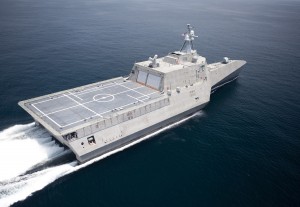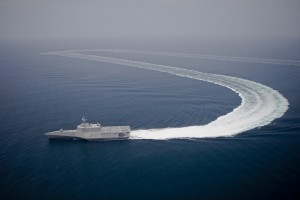 Bath, ME – The Navy’s need for speed is being answered by a pair of warships that have reached freeway speeds during testing at sea.
Bath, ME – The Navy’s need for speed is being answered by a pair of warships that have reached freeway speeds during testing at sea.
Subscribe to our Daily Roundup Email
Independence, a 418-foot warship built in Alabama, boasts a top speed in excess of 45 knots, or about 52 mph, and sustained 44 knots for four hours during builder trials that wrapped up this month off the Gulf Coast. The 378-foot Freedom, a ship built in Wisconsin by a competing defense contractor, has put up similar numbers.
Both versions of the Littoral Combat Ship use powerful diesel engines, as well as gas turbines for extra speed. They use steerable waterjets instead of propellers and rudders and have shallower drafts than conventional warships, letting them zoom close to shore.
The ships, better able to chase down pirates, have been fast-tracked because the Navy wants vessels that can operate in coastal, or littoral, waters. Freedom is due to be deployed next year, two years ahead of schedule.

Up to 55 could be built
Independence is an aluminum, tri-hulled warship built by Austal USA in Mobile, Ala. The lead contractor is Maine’s Bath Iron Works, a subsidiary of General Dynamics.
Lockheed Martin Corp. is leading the team that built Freedom in Marinette, Wis. It looks more like a conventional warship, with a single hull made of steel.
The stakes are high for both teams. The Navy plans to select Lockheed Martin or General Dynamics, but not both, as the builder. The Navy has ordered one more ship from each of the teams before it chooses the final design. Eventually, the Navy wants to build up to 55 of them.
Speed has long been relished by Navy skippers. Capt. John Paul Jones, sometimes described as father of the U.S. Navy, summed it up this way in 1778: “I wish to have no connection with any ship that does not sail fast; for I intend to go in harm’s way.”
Eric Wertheim, author and editor of the U.S. Naval Institute’s “Guide to Combat Fleets of the World,” said speed is a good thing, but it comes at a cost.
“This is really something revolutionary,” Wertheim said. “The question is how important and how expensive is this burst of speed?”
Each could cost $460 million
Early cost estimates for Littoral Combat Ships were about $220 million apiece, but costs spiraled because of the Navy’s requirements and its desire to expedite construction. The cost of the ships is capped at $460 million apiece, starting in the new fiscal year.
Both ships are built to accommodate helicopters and mission “modules” for either anti-submarine missions, mine removal or traditional surface warfare. The modules are designed to be swapped out within 24 hours, allowing the ships to adapt quickly to new missions.
While they’re fast, they aren’t necessarily the fastest military ships afloat. The Navy used to have missile-equipped hydrofoils and the Marines’ air-cushioned landing craft is capable of similar speeds, Wertheim said. And smaller ships are capable of higher speeds.
Nonetheless, the speed is impressive, especially considering that other large naval vessels have been cruising along at a relatively pokey 30 to 35 knots for decades.
Loren Thompson, a defense analyst at the Lexington Institute, noted that Independence sustained 44 knots despite a 30-knot headwind and 6- to 8-foot seas in Alabama’s Mobile Bay. “For a ship of this size, it’s simply unheard of to sustain that rate of speed for four hours,” he said.

Oh sure, that’s pretty fast. But let’s see those ships cruise that fast in uphill water.
Yeah Yeah… long live the king.. wait until Obama & Co. move in and stop the project just like they did to the F22 Jet
F-22 was canceled because there was a better aircraft, the F-35 (JSF).
LCS won’t be canceled, just down-selected to one design.
And, Obama didn’t make the F-22 decision, SecDef Gates (a Bush appointee who Obama kept on), did.
doesnt look like the ship is going too fast..
Secretaries of Defense have been trying to cut back the F22 program for decades, but have been outmaneuvered by the military-industrial lobbies along with congressman after jobs in their districts.
All the armchair analyists progrnostications about 20-year threat assessments don’t change what has been the universal civilian leadership’s opinion over many admisitrations, Democrat and Republican.
Kudos to Obama and Gates for finally reigning the program in, in favor of of defense spending relevant to today’s and tomorrow’s threats, so that we’re not sending soldiers into harm’s way in unarmored Humvees as we were under Bush.
I have a novel idea: why not spend money to build things, instead of spending money on destroying things?